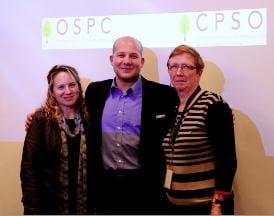The Ottawa Suicide Prevention Coalition is calling on journalists to change how they report the issue of suicide, including for queer youth, who are more likely to attempt suicide than their heterosexual peers.
The coalition presented its guidelines to media at an Oct 19 workshop as part of Ottawa Public Health Week.
They discuss language, story placement and the importance of providing contact information for community suicide prevention resources.
“If you’re following the guidelines while doing the reporting, you can be doing good things,” said Jessica Ripley, strategic youth program specialist at the Ottawa Police Service. “When reporting is done in a safer way, the outcome is positive.”
The coalition represents organizations involved in suicide prevention, including Ottawa Public Health, the Canadian Mental Health Association and the Ottawa Police Service.
As the second leading cause of death among young people aged 18 to 24, suicide is a public health issue, Ripley said.
Using the terms “died by suicide” or “suicided” instead of “committed suicide” is essential, she said.
“We would say someone committed a crime, but we wouldn’t say someone committed cancer,” she said.
All stories on suicide should also include contact information for community resources for suicide prevention and crisis assistance, said Renée Ouimet, division director for the Ottawa branch of the Canadian Mental Health Association.
“You may be triggering people having thoughts of suicide who might not know where to go,” Ouimet said.
Members of the media must make careful decisions about the prominence of suicide coverage, too, said Benjamin Leikin, project officer at Ottawa Public Health’s mental health project.
“Is it on the first page or the fourth? We want it on the fourth,” he said.
Studies show that the more graphic and prominent media coverage of suicide is, the more it triggers people contemplating suicide, Leikin said.
But it’s better to report than not report because discussing suicide keeps people who are contemplating it from feeling isolated, Ouimet said.
Leikin says crisis services experienced a four-month surge after media reported extensively on the November 2010 suicide of Daron Richardson, the 14-year-old daughter of Ottawa Senators assistant coach Luke Richardson.
The coalition said placement of photos and video of a person who has died by suicide is also important.
“Understandably there will be pressure from community to see a picture. But could we put community resources right next to the photo?” Leikin asked.
Photos should be generic – a family, a community, a school. “A family photo shows loss; an individual picture shows isolation,” Ouimet said.
In addition, photos painting the deceased as popular, accomplished or good-looking can sensationalize and romanticize the death, Ripley said.
“Then you might get people thinking, ‘Oh my gosh, look how perfect that person’s life was. What about me?’” she said.
Focusing on one issue can also sensationalize, Leikin said.
“What we’re trying to get at is that there are many factors – it’s complex,” he said.
For instance, sometimes sexual orientation is a story line, when it might not be a factor, said Leikin, noting media tends to zero in on bullying.
“Bullying in itself is not the sole contributing factor to someone taking their life. I think it’s a factor – and sometimes a very large one – but there are always many factors,” he said.
Ripley, Ouimet and Leikin agreed, on the first anniversary of the suicide of Jamie Hubley, a gay Ottawa 15-year-old who was bullied at school, that local reporting has reflected that it wasn’t just bullying that caused his suicide.
“Certainly there is a correlation between bullying and suicide,” Leikin said. “But it’s also important that we don’t just draw the line in the sand and say those who are being bullied are dying by suicide because then others being bullied might look to that as a coping strategy. And we never want that to happen.”
The Distress Centre of Ottawa and regional 24-hour line is 613-238-3311.

 Why you can trust Xtra
Why you can trust Xtra


